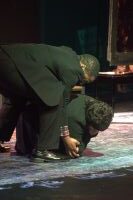The traditional “O Come, Emmanuel” (arranged by Alice Parker) began very sparely and as traditional plainsong sung by women; it soon swelled to a twentieth-century harmonic choral sound that filled St. James Church, and washed over the full-house crowd to their complete satisfaction. Unabashedly modern harmony and the odd three blows on a hand bell, with not-quite-on-tempo organ accompaniment (I don’t think the organist could see the conductor) melded together to start off a fine evening of choral music. The choir moved, with just the slightest break, into Distler’s setting of “Lo! How a Rose E’er Blooming” under the excellent direction of conductor Brad Gee. The second verse was slightly marred by some excessive sibilance, which got even worse in the third.
Next, Britten’s Ceremony of Carols showcased the choir, the harping of Lelia Lattimore, and the unyielding work towards perfection of Maestro Gee. The composition as a whole was completely professional and completely lovely. In the face of such overall excellence, it was easy to excuse such little flaws as will be mentioned. In the third verse of “Wolcum Yule!” the sopranos and altos lost some of the blending that they had mastered in the opening “O Come Emmanuel.” The harshness continued in “There is No Rose”; perhaps this is as good as can be done with women and not boy trebles. Judy Meinzer’s alto solo in “That Yongë Child” was cantabile and unforced. Sandy Salvaggio-Walker was beautiful in “Balulalow.” The greater vibrato of Walker’s voice was perhaps thrown into unfortunate prominence coming so close after Meinzer. The choir was at its Britten best in “As Dew in Aprille,” soaring vaulting, arching, and dancing over the audience. The very challenging “This Little Babe” suffered a trifle from diction problems in the third stanza. Otherwise, the choir’s diction was generally very fine and very clear throughout the whole evening.
Lelia Lattimore’s solo harp interlude is probably the most solo harp that the majority of concert audiences has ever heard. Although her playing was flawless, there was harshness about her fortes that I ascribe to the harp and not to her. Britten’s “In Freezing Winter Night” evokes wind and cold. Gee brought this out perfectly, with the moaning of the wind so realistic that I had a little shiver. Andre Blough and Karen Areheart were perfectly and beautifully matched in “Spring Carol.” After the vigorous “Deo Gracias,” the opening “Hodie” is repeated. This was well sung, but it was clear that so much continuous singing had taken a toll on all the voices. Intermission did not come a measure too soon.
The house was completely sold out, but the efficient team of adult male ushers, such a pleasant change from the old days of volunteer high school students, managed to get everyone seated both the first time and after intermission with hardly a check. Their professionalism, along with the much improved printed program, with complete libretto, are part of the measure of progress Maestro Gee has brought to the CCC, in addition to the great musical strides he has helped them make.
After intermission the program was broken into four arbitrary groups of mostly traditional carols arranged and performed in the style of Robert Shaw. The first set was Warlock’s “Benedicamus Domino” and Robert Lucas Pearsall’s arrangement of “In Dulci Jubilo.” In the latter piece there was excellent balance between the choir and a double quartet consisting of Maria Britton, Regan Burnham, Sandra Kremer, Julie Williams, Wayne Arrowood, David Vaudre, Tim Hoyt, and Brian Tribby.
The second group was two settings of “O Magnum Mysterium,” one by Tomas Luis de Victoria and a second by Morten Lauridsen (b.1943). The setting by Victoria was without question the best singing of the evening. Neither setting benefited from so close a juxtaposition to the other, but the Lauridsen may well have been the second best singing of the evening. Gee’s handling of dynamics and his delicate fiddling with the tempo raised this to a very fine performance indeed. The slight instability of intonation in some of the long suspensions reminds us this is a completely local completely volunteer choir. So, far from being surprised that the dog can walk at all on his hind legs, the choir provided the aural equivalent of the dog dancing Swan Lake on his hind legs. There was very, very little that set the CCC apart at all from a fine professional choir.
One of those very little things, present though not marring in any way, was the somewhat localized diction heard in “Deck The Halls” of the next set, which was coupled with Leontovich’s “Carol of the Bells,” arranged by Wilhousky. This old friend was sung very cleanly, to the delight of the audience. Also in this set were “The Boar’s Head Carol,” :While By My Sheep,” and “As Lately We Watched.” The latter was made especially distinctive by the sweet and clean singing of soprano Sue Hjelsand. The final set consisted of “Fum, Fum, Fum,” the “Cradle Song” version of “Away In A Manger,” and “I Saw Three Ships.” Although the flute playing of Katherine Price and piano accompaniment by Karen Areheart in “Away In A Manger” were very nicely executed they did not enhance the choir in any way. And the undergraduate men’s glee club sound in the same piece is something I imagine Maestro Gee could have gotten out if he’d had more time. “I Saw Three Ships” was the grand finale with choir, piano four hands by Price and Areheart, and brief cell phone obbligato from the rear of the church. The final stanza, preceded by a really fun Hollywood buildup, was thundering closure, which surprisingly did not immediately bring everyone to their feet, but the applause was vigorous and soon everyone was standing in tribute to a fine local choir and its thoroughly professional director, Brad Gee.
Additional performances are scheduled on Saturday, December 2 at 3:00 and 7:00 p.m. See our Western calendar.











